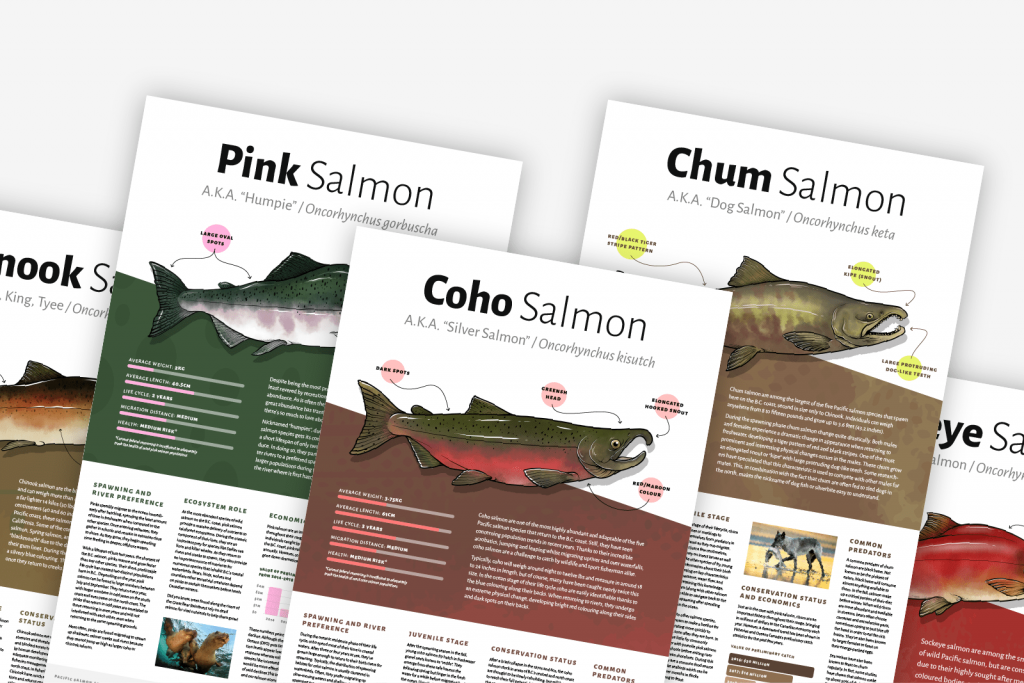In 2002, Raincoast Conservation Foundation produced a call-to-action report, entitled Ghost Runs. The objective was to highlight the growing concern for the status of B.C. salmon. Nearly two decades after its release, concerns are escalating as salmon populations reach alarmingly low numbers.
Key conclusions of Ghost Runs
- The current fisheries management model applied in the North and Central Coasts is flawed and disregards the importance of salmon to multiple tiers of wildlife and the ecosystem as a whole – rather focusing on a single species management method.
- Mixed stock fisheries are destructive to small runs and to genetic diversity
- Enhancement and hatchery initiatives cause loss of diversity and destroy the quantity of wild salmon
- Under existing standards, the presence and expansion of fish farms on the Central and North Coasts poses a threat to wild runs of salmon
- Existing forest practices and regulatory legislation are inadequate and provide very little to protect salmon habitat.
The report outlines the health of the five Pacific salmon species as they were in 2002
Sockeye
In the year 1999, classes registered as depressed or very depressed in 73% of indicator streams. According to statistics, there were minor improvements in 2000/2001, however, most sockeye streams have been extremely depressed since the 1999 assessment.
Coho
Historically, there has been a lack of data availability for the Coho populations, however existing information demonstrated that stocks were severely depressed coast wide leading up to 1999. Status remained as such into the current analysis.
Pink
Pink salmon are historically the healthiest of the five species, however in 1999 only 35% of the indicator streams were meeting their spawning targets, with very strong returns and improvement in 2000-2001. Recent returns do show that Pink are the healthiest of the five species, however these results are still demonstrating depressed runs in 2020.
Chum
Chum has been severely depressed since 1999, with 75% of indicator streams demonstrating less than their targets as spawners. There has been very little change and no recovery in recent years.
Chinook
By 2000, 56% of spawning streams were very depressed. Chinook, being the largest of the five species, already have the lowest population and least number of spawning streams. Chinook salmon remain severely depressed in the Central and North Coast.
Ghost Runs provides answers to key questions about the management and survival of wild salmon. It was determined that ecosystems are not considered when management decisions are made. The government has long operated on a single species management approach and this has proved ineffective. Aquaculture and hatcheries have a negative impact on wild salmon, with the current DFO initiatives being unsuccessful towards the long-term survival of the wild salmon.
Ghost Runs provided some final thoughts and recommendations on how to properly manage our wild salmon populations:
- DFO has typically operated on a Maximum Sustainable Yield (MSY) management model. An ecosystem approach would be better suited for a species as complex as salmon and would support lower exploitation levels. This method, although recommended as far back as 2002, has yet to be adopted and remains a widely-endorsed option for healthy ecosystem management.
- The second recommendation is to properly manage salmon populations to preserve genetic diversity. Interbreeding has been observed between populations of Atlantic farmed salmon and Pacific salmon species, resulting in offspring not being viable. This is an ongoing problem with open pen net salmon farming and remains a prevalent issue.
- Replacing a mixed stock fishery with selective fisheries means ensuring that fishing is done within individual rivers and spawning streams. Therefore, populations and rivers that are struggling can remain closed and rivers determined to be in good health can take the burden of the fishing pressure (in the fisheries year).
- Hatcheries should be phased out as a method to enhance wild salmon production and they should be replaced with watershed-based solutions.
- Any expansion of fish farms in B.C. should cease until contamination and pollution spilling over to wild populations can be mitigated. This recommendation is also included in the DFO Cohen Commission Report, where a date of September 30, 2020 had been given-and lapsed- for the state of B.C. fish farms to have demonstrated improvements.
- Because salmon are an integral component to ecosystem function, watersheds need to be safeguarded to protect spawning habitat. Management for wild salmon cannot end at the intersection of oceans and rivers.
- Stewardship programs and management should occur in collaboration with communities. This practice develops expertise and involvement within communities and ensures that the needs of those relying on salmon are being met.
Ghost Runs is a comprehensive report that was published nearly two decades ago, yet the problems outlined remain prevalent today. The report presented very attainable solutions to combat the decline in wild salmon populations. The seven recommendations outlined above continue to be pertinent today;at the current rate of decline in the wild salmon populations, another two decades of complacency could result in disastrous consequences along with new and accelerating factors of global warming, ocean acidification, and industrial encroachment mean the window to save salmon is rapidly closing. Saving pacific salmon is a doable and necessary step not only for the health of our coast, but in meeting our climate change and environmental targets as a United Nations member.
Works Cited
- Harvey, B., and M. MacDuffee — editors. 2002. Ghost Runs: The future of wild salmon on the north and central coasts of British Columbia. Raincoast Conservation Foundation. Victoria, BC.







